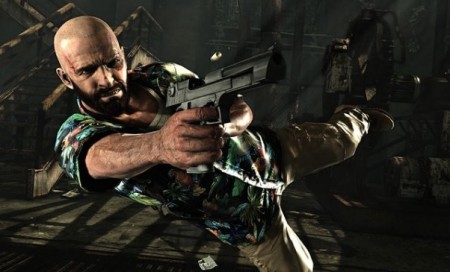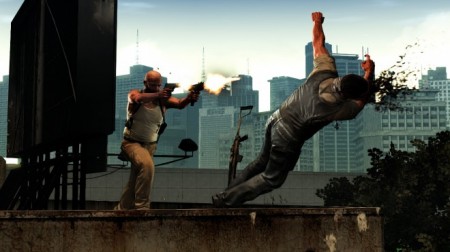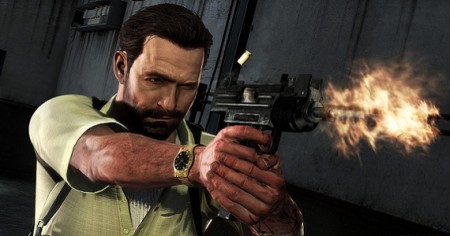Max Payne 3 – The Verdict
Max Payne 3 has been a long time coming, and this caused some concern for me. Given that almost a decade has passed since Max Payne 2, accompanied by a change of development team, I was initially apprehensive as to whether Max’s third outing would hold my attention in the same way as its predecessors. As it turns out, though, I needn’t have worried.
In less than five minutes I was drawn back into Max’s murky world of violence. Allow me to set the scene: A rooftop party had run awry, the boss’s wife had been taken hostage, and an inter-woven cinematic presented our anti-hero, Max, carefully assessing his play. Ingenuity or perhaps foolishness took over and without warning Max launched himself from the balcony above, sliding on his back down a rooftop panel, gun in hand. As the game threw control back into my favour, I tentatively squeezed the trigger and fired, praying I hit my target. Cue another cinematic sequence showing Max falling unceremoniously into a splash pool below, as the former captor (now sporting a fresh bullet wound between the eyes) toppled over the railings behind him. The boss’s wife was free and, with any personal concerns about the quality of Max Payne 3 well and truly banished, I was hooked.
Rockstar has really managed to capture the essence of the Max Payne series, despite the lapse of time and significant changes to the world of Payne we’ve grown to love. This time round New York has been sidelined for São Paulo, with Max working a private security gig for Brazil’s richest family courtesy of an old friend from the police academy, Raul Passos. And despite the scorching midday sun, colourful setting and a rather questionable Hawaiian shirt that Max dons during the second act, accompanied by an equally questionable haircut, the tone remains as dark as we’ve come to expect from this series.
Frequent references to Max’s alcoholism and drug abuse help to further amplify his troubled past, something that’s referenced within the game on a regular basis; cut scenes often demonstrate periods of double vision, playing back to Max’s alcohol dependencies, whilst popping painkillers to restore health will temporarily blur your surroundings. Despite the years, Max hasn’t changed – he’s still most comfortable with a drink in his hand and a belly full of pills, both of which feature in abundance as Passos’ promise of an “easy ride” for Max inevitably doesn’t pan out.
Max Payne 3 is heavily cinematic right from the get-go, to the extent that you’ll sometimes feel like a passenger rather than a key-player, as the narrative charges forward with only the briefest of gameplay segments sandwiched between two rather lengthy cinematic sequences. However, Rockstar has cleverly hidden the loading screens in this fashion, creating a game with a film-style presentation – the unbroken action completely void of any pauses helps to create a certain level of immersion not found in other shoot-em-ups. It’s certainly an alternative method of storytelling, and one you’ll quickly grow to love or hate. Unfortunately, the action focused among you may fall into the latter category, and the all too frequent gameplay pauses due to lengthy cut scenes, designed to push the plot forward, may prove to be a breaking point.
Payne’s signature bullet-time mechanic also makes a return for this third outing, allowing you to throw Max around the environment any which-way, whilst dispatching enemies in slow motion. Dropping the final perp in the room will also activate an additional slow-mo feature where the camera will track the progress of your final bullet until it hits your intended target. It’s a cool effect, and one that helps to extend the feeling that Max Payne 3 isn’t just a game, it’s a cinematic experience.
Given this rather visually appealing film-esque style of storytelling and immersion, however, Max Payne 3 suffers from a lack of replayability. You’ll probably want to run through the singleplayer porition of the game a few months down the line, but there’s nothing here to make you want to start from scratch as soon as the credits have finished rolling; the story is tense, gripping and dark, but it’s also a once-only kind of deal. Rockstar has included a “golden gun” feature, akin to GTA’s hidden package concept, but it’s really only an attractive addition for completionists.
Still, for that first playthrough, immersion is a trend that’s present throughout the game, particularly in relation to the HUD. Indicators for your health, bullet time allowance and ammo count are tucked away in the bottom right, whilst the rest of the screen is a blank canvas, ready to be filled by a hail of gunfire and the horde of dead bodies you’ll leave in your wake. Rockstar has also been delightfully creative with the in-game environments; enemies can be dispatched by dropping objects from a great height, by destroying their makeshift cover or by shooting the genre-specific propane canisters that litter the landscape in abundance.
There’s also something to be said for the weapon management used within this game, as Max’s carrying capability is restricted by what’s plausible. Throughout the game, Max utilises a twin weapon holster slung over his shoulders, with each holster able to accommodate a pistol or an uzi. Max can then physically carry a rifle, allowing for a maximum of three weapons to be held at any one time. Although credit is most certainly due for the degree of realism provided here, replacement magazines for in-game weapons have not been afforded the same luxury. When reloading, Max will reach to his side and pull a magazine from thin air, shattering the illusion somewhat.
Further problems stem from the sort of “sixth sense” enemies seem to possess, most notable on the harder difficulty settings. Any attempt at stealth (particularly during the few points in the game where you’re provided with a silenced weapon) is therefore impossible to take advantage of – even enemies with their back turned will notice your presence in a heartbeat, immediately alerting any of their friends in the nearby vicinity before promptly showering you with a hail of gunfire and a quip delivered in the local tongue.
This issue is also compounded towards the end of the game where Max Payne 3 gets unusually difficult. Fortunately this doesn’t prove to be too much of a problem due to Rockstar’s decision to provide additional painkillers and damage reductions if you have to retry a particular section a number of times over, but the difficulty spike still feels unnecessary and perhaps even a little unbalanced.
Once you’ve blasted your way through the singleplayer, you can then turn you attention to the arcade and multiplayer modes. Arcade is a time trial, points-based mini-game of sorts, with leaderboard functionality, where you can play through any chapter from the storyline to try and set your best score. The multiplayer is rather impressive, too, sporting a number of game modes to keep you occupied for a while longer after finishing the singleplayer – and whilst it doesn’t make for a standalone reason to buy the game, it’s certainly an added bonus.
There are a few flaws here, sure, but all-in-all Max Payne 3 is an incredibly rewarding experience; the controls are tight, the gameplay is fluid and the graphics are both inviting and immersive. Rockstar has produced an excellent continuation to the Max Payne series, accessible to both veterans and newcomers alike, making Max Payne 3 a game entirely deserving of ‘headshot’ status, just ever so narrowly missing ‘red mist’ calibre.
Verdict – Headshot
Platforms available – Xbox 360, PS3, PC
Platform reviewed – Xbox 360


